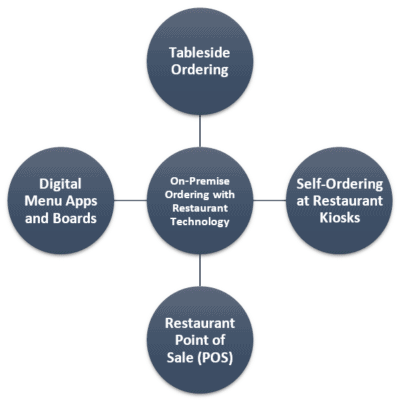
Technology is constantly changing and revolutionizing the way restaurants meet customer needs. Gone are the days when servers would approach a customer with a pen and paper. Today, technology is at the helm of on-premise ordering processes. Customers in the restaurant industry can directly place their orders on tableside tablet systems. The new technology also allows servers to enter customer orders on hand-held devices. To get a better understanding of the changes happening in this space, let’s have a look at the technology being used to streamline on-premise ordering:
Restaurant Point of Sale (POS) System
The heart of efficient on-premise ordering lies with the restaurant point of sale (POS) system. For instance, a mobile point of sale (mPOS) streamlines communication between several stations within the restaurant and provides data in tandem. Such a system is easy to install and simplifies the entire process from order taking to serving the customer.
The role of POS systems today cannot be overlooked. They are a hybrid system that can take orders, process credit card payments, print receipts, operate as a server station, and display information on a user-friendly screen. The benefits of a POS system to the on-premise ordering process include:
- Tracking daily cash in and cash out
- Recording payment methods used by each guest
- Tracking and measuring sales metrics
- Generating sales report for different periods of time
- Gathering and storing real time customer information
Tableside Ordering System
Among the revolutionary on-premise restaurant ordering technologies is tableside ordering. Restaurants are using tableside touch screen ordering systems to provide better services to customers. The ordering process involves the server or the guest inputting their order on a tableside screen. With the aim being to satisfy the needs of the customers, most of these systems are tailored to the customer.

The tableside ordering system is integrated into the restaurant POS system for a smooth flow of orders. Upon integration, the tableside POS system provides restaurant owners and managers with a simple pay-at the-table solution. The process involves the guest selecting menu items from a list on the tableside tablet or smartphone. This step allows for customization of the order to include add-ons and menu items.
Once the order has been made, it is automatically sent to the kitchen for preparations. After the meal has been prepared, the server brings it to the customer’s table. This eliminates the needs of the server to take orders manually and go back and forth to the kitchen. The system speeds up customer service and allows servers to attend to other customers while the order is being fulfilled.
Tableside pos systems are more ideal for bars and casual dining restaurants, which are looking for ways to increase table turn time. Apart from the ordering functionality, the systems also come with games and welcoming messages to attract and engage the customer.
Self-Ordering at Restaurant Kiosks
Self-ordering at restaurant kiosks is another revolutionary of serving customers. The process works in almost a similar manner to tableside ordering. The difference is that restaurant kiosks are free-standing. With a tableside ordering system, the guest selects menu items from a screen at their table. On the contrary self-ordering kiosk involves the guests walking to the kiosk to place the order. At the kiosk, the guest will select what they want from the menu list, place their order, and make their payment. They will then be notified to pick up their food.
Restaurant self-ordering kiosks work well with quick service restaurants, fast casual
restaurants, and casual dining restaurants. These are the establishments with high customer traffic that need to speed up the ordering process. Since kiosks are free-standing physical structures, customers can choose what they want and place their orders without the intervention of the server or cashier.
Self-ordering kiosks are integrated into the restaurant POS system to provide a seamless experience to the customers. Several leading restaurants including McDonald’s, Taco Bell, and Panera Bread are implementing this ordering system for its obvious benefits. Self-ordering at restaurant kiosks:
- Increases the speed of service, reduces wait time, improves restaurant efficiency, and speeds table turnover.
- Offers customers a wide variety of food options to choose from.
- Appeals to millennials, the largest restaurant customer market.
- Offers opportunities for add-ons and upsells.
- Saves labor costs while improving revenue generated through better customer experience.
- Streamlines restaurant operations by automating the ordering process
- Improves the efficiency of the order delivery process
Digital Menu Apps and Boards
Many restaurants, bars, and cafes are now using digital menus over the historical paper ones. This new technology allows customers to place digital orders on mobile devices. Specifically, the customer places an order on the restaurant mobile app, based on options offered. The order is then transferred to the kitchen for expedited delivery. To create a user-friendly and engaging menu, digital menu apps and boards come in handy.
Digital menu mpps may be used to upload menu images, customize product details, and increase the aesthetics of the digital menu. Restaurant owners and managers use the apps to create, edit, and manage their restaurant digital menus and display them on TV screens easily. This helps in improving customer experience and making the menu more engaging to the customers.
Digital menu apps help restaurant owners and managers customize their menu to fit specific customer segments. They can decide the items to include and how to price them. They can also highlight ingredients, or rotate certain menu items depending on the hour or day. Digital menu apps also help to update everything on the menu. Restaurant owners can easily display pop-ups or banners for promotions like happy hours and daily specials. They also ensure that the front-of-house staff can easily access the menu when taking orders and orders can easily customize their orders at tableside ordering or self-service kiosk.
Digital menu boards provide clear and detailed menu items on the screen. They provide additional features that allow you to add all menu items and categorize them for easier understanding by the customers. For instance, the control panel of a digital menu board allows you to create menu items with description, price, and calorie information.
This technology is more popular in quick-service establishments and coffee shops because of additional features that allow sharing of information. Customers can use the tools on the board to share their menu choices with others, leave reviews, make social media mentions, and share photos.
Conclusion
Technology has revolutionized the restaurant ordering process. Servers no longer take customer orders using a pen and paper. Restaurant POS systems and tableside screens allow guests to select what they want from the menu items and place their orders directly to the kitchen. The role of servers is transforming as they now deliver orders placed by customers directly on the system. Self-ordering kiosks, digital menu apps, and digital menu boards are transforming this space by giving customers more power when placing their orders.



